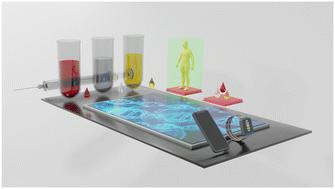Our official English website, www.x-mol.net, welcomes your feedback! (Note: you will need to create a separate account there.)
Tailored point-of-care biosensors for liquid biopsy in the field of oncology
Lab on a Chip ( IF 6.1 ) Pub Date : 2022-10-27 , DOI: 10.1039/d2lc00666a Sima Singh 1 , Pritam Saha Podder 2 , Matt Russo 3 , Charles Henry 3 , Stefano Cinti 1, 4
Lab on a Chip ( IF 6.1 ) Pub Date : 2022-10-27 , DOI: 10.1039/d2lc00666a Sima Singh 1 , Pritam Saha Podder 2 , Matt Russo 3 , Charles Henry 3 , Stefano Cinti 1, 4
Affiliation

|
In the field of cancer detection, technologies to analyze tumors using biomarkers circulating in fluids such as blood have developed rapidly based on liquid biopsy. A proactive approach to early cancer detection can lead to more effective treatments with minimal side effects and better long-term patient survival. However, early detection of cancer is hindered by the existing limitations of conventional cancer diagnostic methods. To enable early diagnosis and regular monitoring and improve automation, the development of integrated point-of-care (POC) and biosensors is needed. This is expected to fundamentally change the diagnosis, management, and monitoring of response to treatment of cancer. POC-based techniques will provide a way to avoid complications that occur after invasive tissue biopsy, such as bleeding, infection, and pain. The aim of this study is to provide a comprehensive view of biosensors and their clinical relevance in oncology for the detection of biomarkers with liquid biopsies of proteins, miRNA, ctDNA, exosomes, and cancer cells. The preceding discussion also illustrates the changing landscape of liquid biopsy-based cancer diagnosis through nanomaterials, machine learning, artificial intelligence, wearable devices, and sensors, many of which apply POC design principles. With the advent of sensitive, selective, and timely detection of cancer, we see the field of POC technology for cancer detection and treatment undergoing a positive paradigm shift in the foreseeable future.
中文翻译:

用于肿瘤学领域液体活检的定制床旁生物传感器
在癌症检测领域,基于液体活检,利用血液等液体中循环的生物标志物分析肿瘤的技术得到了快速发展。一种积极主动的早期癌症检测方法可以带来更有效的治疗,副作用最小,患者的长期生存率更高。然而,传统癌症诊断方法的现有局限性阻碍了癌症的早期检测。为了实现早期诊断和定期监测并提高自动化程度,需要开发集成的即时护理 (POC) 和生物传感器。预计这将从根本上改变癌症治疗反应的诊断、管理和监测。基于 POC 的技术将提供一种方法来避免侵入性组织活检后发生的并发症,例如出血、感染和疼痛。本研究的目的是全面了解生物传感器及其在肿瘤学中的临床相关性,以检测具有蛋白质、miRNA、ctDNA、外泌体和癌细胞液体活检的生物标志物。前面的讨论还说明了通过纳米材料、机器学习、人工智能、可穿戴设备和传感器进行基于液体活检的癌症诊断的不断变化的前景,其中许多应用了 POC 设计原则。随着灵敏、选择性和及时检测癌症的出现,我们看到用于癌症检测和治疗的 POC 技术领域在可预见的未来正在经历积极的范式转变。和癌细胞。前面的讨论还说明了通过纳米材料、机器学习、人工智能、可穿戴设备和传感器进行基于液体活检的癌症诊断的不断变化的前景,其中许多应用了 POC 设计原则。随着灵敏、选择性和及时检测癌症的出现,我们看到用于癌症检测和治疗的 POC 技术领域在可预见的未来正在经历积极的范式转变。和癌细胞。前面的讨论还说明了通过纳米材料、机器学习、人工智能、可穿戴设备和传感器进行基于液体活检的癌症诊断的不断变化的前景,其中许多应用了 POC 设计原则。随着灵敏、选择性和及时检测癌症的出现,我们看到用于癌症检测和治疗的 POC 技术领域在可预见的未来正在经历积极的范式转变。
更新日期:2022-10-27
中文翻译:

用于肿瘤学领域液体活检的定制床旁生物传感器
在癌症检测领域,基于液体活检,利用血液等液体中循环的生物标志物分析肿瘤的技术得到了快速发展。一种积极主动的早期癌症检测方法可以带来更有效的治疗,副作用最小,患者的长期生存率更高。然而,传统癌症诊断方法的现有局限性阻碍了癌症的早期检测。为了实现早期诊断和定期监测并提高自动化程度,需要开发集成的即时护理 (POC) 和生物传感器。预计这将从根本上改变癌症治疗反应的诊断、管理和监测。基于 POC 的技术将提供一种方法来避免侵入性组织活检后发生的并发症,例如出血、感染和疼痛。本研究的目的是全面了解生物传感器及其在肿瘤学中的临床相关性,以检测具有蛋白质、miRNA、ctDNA、外泌体和癌细胞液体活检的生物标志物。前面的讨论还说明了通过纳米材料、机器学习、人工智能、可穿戴设备和传感器进行基于液体活检的癌症诊断的不断变化的前景,其中许多应用了 POC 设计原则。随着灵敏、选择性和及时检测癌症的出现,我们看到用于癌症检测和治疗的 POC 技术领域在可预见的未来正在经历积极的范式转变。和癌细胞。前面的讨论还说明了通过纳米材料、机器学习、人工智能、可穿戴设备和传感器进行基于液体活检的癌症诊断的不断变化的前景,其中许多应用了 POC 设计原则。随着灵敏、选择性和及时检测癌症的出现,我们看到用于癌症检测和治疗的 POC 技术领域在可预见的未来正在经历积极的范式转变。和癌细胞。前面的讨论还说明了通过纳米材料、机器学习、人工智能、可穿戴设备和传感器进行基于液体活检的癌症诊断的不断变化的前景,其中许多应用了 POC 设计原则。随着灵敏、选择性和及时检测癌症的出现,我们看到用于癌症检测和治疗的 POC 技术领域在可预见的未来正在经历积极的范式转变。


























 京公网安备 11010802027423号
京公网安备 11010802027423号